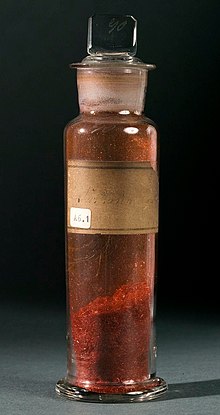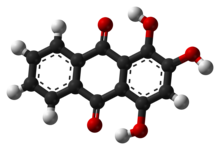1,2,4-Trihydroxyanthraquinone, commonly called purpurin, is an anthraquinone. It is a naturally occurring red/yellow dye. It is formally derived from 9,10-anthraquinone by replacement of three hydrogen atoms by hydroxyl (OH) groups.

| |

| |

| |
| Names | |
|---|---|
| Preferred IUPAC name
1,2,4-Trihydroxyanthracene-9,10-dione | |
| Other names
Purpurin, Purpurine, Hydroxylizaric acid
| |
| Identifiers | |
3D model (JSmol)
|
|
| ChEBI | |
| ChEMBL | |
| ChemSpider | |
| ECHA InfoCard | 100.001.237 |
| KEGG | |
PubChem CID
|
|
| UNII | |
CompTox Dashboard (EPA)
|
|
| |
| |
| Properties | |
| C14H8O5 | |
| Molar mass | 256.21 g/mol |
| Melting point | 259 °C (498 °F; 532 K)[1] |
Except where otherwise noted, data are given for materials in their standard state (at 25 °C [77 °F], 100 kPa).
| |
Purpurin is also called verantin, smoke Brown G, hydroxylizaric acid, and C.I. 58205. It is a minor component of the classical lake pigment "madder lake" or Rose Madder.
History
editMadder root has been used for dying cloth at least since 1500 BC.[2] Purpurin and alizarin were isolated from the root by Pierre Robiquet and Colin, two French chemists, in 1826. They were identified as anthracene derivatives by Gräbe and Liebermann in 1868. They also synthesized alizarin from bromoanthraquinone, which, together with the conversion of alizarin into purpurin published previously by M. F. De Lalande, provided the first synthetic route to purpurin.[3] The positions of the OH groups were determined by Bayer and Caro in 1874–1875.[4]
Natural occurrence
editPurpurin occurs in the roots of the madder plant (Rubia tinctorum), together with alizarin (1,2-dihydroxyanthraquinone). The root actually contains colorless glycosides of the dyes.
Properties
editPurpurin is a crystalline solid, that forms orange-red needles melting at 259 °C (498 °F).[1] It becomes red when dissolved in ethanol, and yellow when dissolved with alkalis in boiling water. It is insoluble in hexane but soluble in chloroform, and can be obtained from chloroform as reddish needles.[5] Unlike alizarin, purpurin is dissolved by boiling in a solution of aluminium sulfate, from which it can be precipitated by acid. This procedure can be used to separate the two dyes.[6]
Like many dihydroxy- and trihydroxyanthraquinones, pupurin has a purgative action, although only 1/20 as effective as 1,2,7-trihydroxyanthraquinone (anthrapurpurin).[7]
Uses
editPurpurin is a fast dye for cotton printing and forms complexes with various metal ions. It fades faster than alizarin on exposure to sunlight.[2]
A study published in Nature journal Scientific Reports suggests that the purpurin could replace cobalt in lithium-ion batteries.[8] Eliminating cobalt would mean eliminating a hazardous material, allow batteries to be produced at room temperature, and lower the cost of recycling batteries. Extracting purpurin from farmed madder is a simple task; alternately, the chemical could be synthesized in a lab.[9]
See also
edit- Trihydroxyanthraquinone
- Pierre Robiquet, discoverer of purpurin in 1826
References
edit- ^ a b Haynes, William M., ed. (2016). CRC Handbook of Chemistry and Physics (97th ed.). CRC Press. p. 3.530. ISBN 9781498754293.
- ^ a b Madder Root Archived 2011-07-14 at the Wayback Machine catalog entry at Natural Pigments website. Accessed on 2010-01-22.
- ^ Chemical news and journal of industrial science, Volume 30, Page 207
- ^ Wahl, Andre; Atack, F. W (1919) The Manufacture Of Organic Dyestuffs. G. Bell And Sons, Limited. Online version accessed on 2010-01-22.
- ^ Vankar, Padma S.; Shanker, Rakhi; Mahanta, Debajit; Tiwari, S.C. (2008). "Ecofriendly sonicator dyeing of cotton with Rubia cordifolia Linn. using biomordant". Dyes and Pigments. 76 (1): 207–212. doi:10.1016/j.dyepig.2006.08.023.
- ^ Irving Wetherbee Fay (1919) The chemistry of the coal-tar dyes. Van Nostrand Online version accessed on 2010-01-22.
- ^ Alister McGuigan, Hugh (1921) An introduction to chemical pharmacology; pharmacodynamics in relation to chemistry. P. Blakiston's son, Philadelphia.
- ^ Reddy, Arava Leela Mohana; Nagarajan, Subbiah; Chumyim, Porramate; Gowda, Sanketh R; Pradhan, Padmanava; Jadhav, Swapnil R; Dubey, Madan; John, George; Ajayan, Pulickel M; Ajayan, Pulickel M (2012). "Lithium storage mechanisms in purpurin based organic lithium ion battery electrodes". Scientific Reports. 2: 960. Bibcode:2012NatSR...2E.960R. doi:10.1038/srep00960. PMC 3518813. PMID 23233879.
- ^ Chirgwin, Richard (12 December 2012). "Dying to make greener batteries". The Register. Retrieved 12 December 2012.